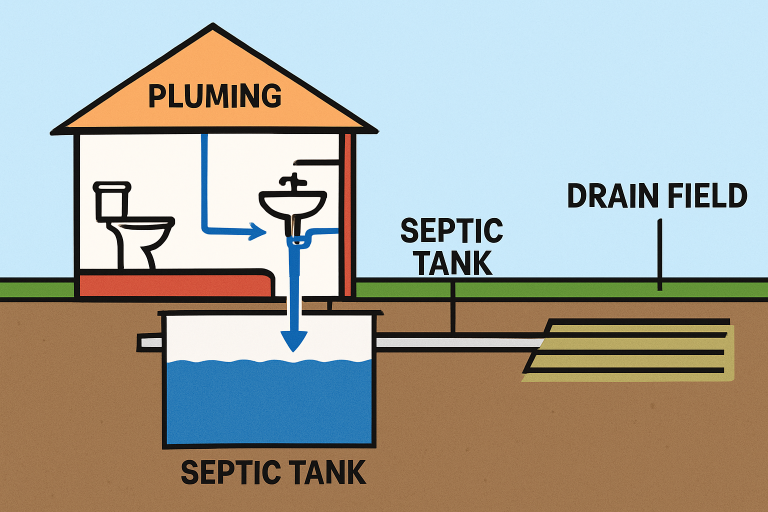Key Takeaways
- Routine septic tank pumping is critical for preventing system failures and protecting local water sources.
- Recognizing warning signs early helps prevent expensive and inconvenient repairs.
- Smart daily water usage and correct waste disposal habits significantly extend the life of a septic system.
Proper septic system maintenance is critical for ensuring a healthy home environment and avoiding expensive emergencies. Regular septic pumping is not just a routine chore—it's a foundational aspect of responsible homeownership that keeps your system functioning efficiently and protects your family and the environment. By staying proactive, you can prevent inconvenient breakdowns and costly repairs.
Your septic system handles all the wastewater from your home, which, if neglected, can lead to foul odors, plumbing backups, and even soil and groundwater contamination. The following guide provides practical tips and essential know-how for every homeowner to keep their septic tanks in optimal working order. Understanding when servicing is needed and applying proven best practices ensures a longer system lifespan and greater peace of mind.
Beyond emergency relief, investing in routine maintenance shifts the focus to longevity and the prevention of environmental hazards. Whether you’ve recently moved into a new home or have relied on your septic system for years, following expert-recommended pumping and care habits will reward you with reliability and lower upkeep costs through the years.
Understanding options like septic unit installation is beneficial if you're considering home upgrades or encountering issues beyond pumping. For significant system improvements, professional guidance ensures your upgrade suits your property’s needs and local regulations.

Understanding Septic Tank Pumping
Septic tank pumping refers to the process of removing built-up sludge and scum that accumulate in your tank over time. As solids settle and decompose, a portion remains at the bottom of your tank. This buildup can block the system if not removed, leading to messy, hazardous overflows and permanent damage. Regular pumping ensures waste is handled hygienically and efficiently.
When a septic tank isn’t pumped on schedule, non-degradable materials accumulate, overwhelming the system’s capacity. This leads to backups in household plumbing, saturated soil around the drain field, and costly, sometimes irreparable, system failures. Pouring septic-safe additives down the drain isn’t a substitute for professional pumping, as only mechanical removal truly clears out settled sludge and scum layers.
Recommended Pumping Frequency
The frequency with which a septic tank requires pumping is driven by factors such as household size, tank size, water consumption, and laundry habits. For most homes, the standard advice is to pump the tank every three to five years, but households with high usage or small tanks may need more frequent service. The U.S. Environmental Protection Agency notes that homes with larger families or frequent guests must pump more often.
Consult a local septic professional to assess your home’s requirements and establish a customized maintenance schedule. Timely intervention resets your system, helping prevent backups and overflows during heavy rain or high household water use periods.
Signs Your Septic Tank Needs Pumping
Learning to spot the warning signs of a complete or struggling septic tank is vital for early intervention. Some key indicators that your septic tank may require immediate pumping include:
- Slow or sluggish drains in kitchen sinks, bathtubs, and toilets.
- Persistent, unpleasant odors either from inside your drains or around the outdoor tank area.
- Pooled water or inexplicably green, lush patches of grass above the drain field.
- Unusual gurgling noises inside pipes, particularly after flushing the toilet.
Ignoring these red flags can lead to widespread contamination and significant property damage. Address signs promptly to avoid larger health and financial issues.
Best Practices for Septic System Maintenance
Conserve Water
Reducing excess water usage relieves strain on your septic system, lowering the likelihood of overloads and leaks. Address leaks immediately and use water-saving fixtures throughout your home. Stagger laundry and dishwasher loads to allow your system time to process wastewater efficiently.
Proper Waste Disposal
Be vigilant about what you send down your drains. Flushing items like wipes, feminine hygiene products, or pouring grease and harsh chemicals can disrupt the bacteria that break down your tank's waste. Stick to biodegradable products and consider using septic-safe cleaning supplies.
Protect the Drain Field
Keep heavy vehicles, sheds, and deep-rooted trees or shrubs away from your drain field. Weight and roots can clog or damage the pipes and soil, leading to system collapse. Regularly inspect the drain field area for signs of excess moisture or growth, indicating leaking or clogging.
Scheduling Professional Inspections
A regular inspection schedule, recommended annually or at least every other year, helps catch minor issues before they escalate. Licensed septic professionals use specialized equipment to check filter screens, tank integrity, and drain field function. Their expert assessments can extend your system's life and prevent serious emergencies.
Environmental Considerations
Failing septic systems pollute groundwater and surface water, leaching bacteria and nutrients into soil and local waterways. This contamination impacts community health and neighboring property values. Commit to regular maintenance to help keep neighborhood water supplies and recreational lakes safe for everyone, minimizing your ecological footprint.
Conclusion
Maintaining your septic system through timely pumping, mindful water use, responsible waste management, and regular professional inspections guarantees reliable performance and peace of mind. Homeowners who prioritize these fundamental steps help protect public health, the environment, and their investment in their property for years to come.



No comments:
Post a Comment
I love reading and responding to comments but in order to get my reply you must ensure you are NOT a no-reply blogger. If you are, here are some quick steps to change that!
1. Go to the home page of your Blogger account.
2. Select the drop down beside your name on the top right corner and choose Blogger Profile.
3. Select Edit Profile at the top right.
4. Select the Show My Email Address box.
5. Hit Save Profile.